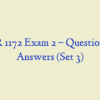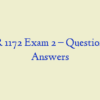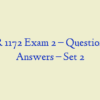Description
NAPSRX PRACTICE QUESTIONS- TEST PREP
Quiz 1 , Chapter 1
- Pharmaceuticals are arguably the most socially important healthcare product.
- Pharmaceutical development is a high-risk undertaking, in which many promising leads prove disappointing.
- Pharmaceutical sales are highest in which geographical regions?
- The U.S. accounts for about of the world’s pharmaceutical revenues.
- Which of the following has fueled recent growth in the pharmaceutical industry?
- According to your manual, which statement accurately describes the predicted relationship between pharmaceutical companies and genomic research facilities?
- Prescription drug therapy is not cost-effective for insurance companies and healthcare providers.
- The high price of healthcare is explained by the high price of medicines.
- One of the oldest and least effective pharmaceutical marketing techniques is DTC (direct-to-consumer) advertising.
- What influences the number of districts in a region?
- What is an example of the regionalization of healthcare delivery systems?
- The heart of a pharmaceutical sales team is the Regional Manager.
- Most DMs did not start as representatives.
- How many territories are in a typical district?
- What is the most effective method for grabbing market share?
Quiz 2 , Chapter 2 & 3
- Pharmaceutical reps mainly visit pharmacies.
- It usually only takes 1-2 calls to a physician before he or she commits to prescribing your product.
- The pharmacist may dispense a product other than what the physician prescribed
- According to Chapter 12 of your manual, which of the following would classify as “payers”?
- According to your manual, what defines “ethical pharmaceutical companies”?
- One of the most disappointing results of the pharmaceutical industry’s continued investment in R & D is the few new drugs being approved and in development.
- Thanks to modern medicines, how long are people newly diagnosed with HIV expected to live?
- How much has the average American lifespan increased since 1890?
- What is a treatment group?
- What is the main difference between a blinded and double-blinded study?
- What does “asymptomatic” mean?
Quiz 3 , Chapter 4
- Which term denotes the study of bodily functions (as opposed to structures)?
- In its broadest definition, a drug is any substance that produces a physical or psychological change in the body.
- How does the Federal Food, Drug and Cosmetic Act (FFDCA) define a drug?
- Which statement about vitamins is CORRECT?
- ADME testing measures the rate at which the body absorbs the drug, distributes it to the organs necessary to produce the desired effect, metabolizes it into waste material and then excretes it from the body.
- ADME testing is primarily used in what field?
- Which statement about placebos is CORRECT?
- On average, only about 5 of 4,000 drugs studied in the laboratory are eventually studied in people.
- Which statement is TRUE about drugs taken sublingually?
- What are 3 of the 7 rights of drug administration?
- Pro-drugs are administered in an active form, which is metabolized into an inactive form.
- The kidney of an 85-year-old person excretes drugs only as efficiently as that of a 35-year-old person.
- The normal age-related decrease in kidney function can help doctors determine an appropriate dosage based solely on a person’s age.
- What DIFFERENTIATES a caplet from a tablet?
- Where will you find the legend “Caution: Federal Law prohibits dispensing without a prescription”?
- What happens in slow acetylators?
Quiz 4 , Chapter 4
- About of the people in the U.S. are “slow acetylators.”
- Which of the following statements about drug-drug interactions is INCORRECT?
- Smoking decreases the effectiveness of some drugs.
- Which of the following statements about dietary supplements is INCORRECT?
- Which statement/s is/are INCORRECT about an ideal drug, or “magic bullet” as Ehrlich phrased it?
- Which statement accurately differentiates resistance from tolerance?
- Between 3% and 7% of hospital admissions in the United States are estimated to be for treatment of adverse drug reactions.
- Which statement is true about the universal scale for quantifying the severity of an adverse drug reaction?
- Why is noncompliance a serious public health concern?
- Which of the following is NOT eligible for patent protection under U.S. regulations?
- Like foods and household products, generic drugs are usually lower quality than the brand name drugs for which they are marketed as equivalents.
- Legally, bioequivalence of different versions of a drug can vary by up to .
- Which of the following statements about biologics is INCORRECT?
- “Large molecule” products are developed and manufactured by a chemical process.
- What are drugs that attract or bind to cell receptors in order to mimic or enhance activities by endogenous chemical messengers?
Quiz 5 , Chapter 4
- Which term denotes how an API works in the body?
- What cements the active and inert components together to maintain cohesive portions?
- What does the medical abbreviation “BID” denote?
- What is the medical abbreviation for “as needed”?
- Which components might cause patients’ different reactions to brand name and generic drugs?
- All cells have a nucleus.
- Which of the following does NOT affect drug response?
- Drug reactions are predictable because they do not occur after a person has been previously exposed to the drug one or more times without any allergic reactions.
- What is the typical relationship between a drug’s site of administration and site of action?
- What is CMAX?
- Which of the following is NOT a main concept in clinical pharmacology?
- Which of the following is NOT a route of drug administration?
- How are intradermal drugs delivered?
- What is an example of intravenous drug delivery?
- What are the major organs of the gastrointestinal system?
Quiz 6 , Chapter 6
- Who is normally responsible for selling to distributors?
- How often do secondary drug wholesale distributors buy their drugs directly from manufactures?
- By FDA law, large chain pharmacies are not allowed to buy directly from drug manufactures.
- Only 3 companies account for nearly 90% of all drug wholesale sales.
- What type of sale bypasses the need for intermediary distributors?
- What is a group purchasing organization (GPO)?
- Prescriptions dispensed by mail-order pharmacies are, on average, around than those dispensed by retail pharmacies.
- Which of the following is NOT a type of non-stock sale?
- What is another term for rebates?
- The PDMA is the Prescription Drug Manufacturers Association.
- A company that owns and operates three or fewer pharmacies is an .
- Which section of a drug’s package insert information covers the usual dosage range?
- Drug labels must include indications, usage information, and contraindications.
- What should be included in the “description” section of a drug’s package insert information?
Quiz 7 , Chapter 7
- Exclusivity gives exclusive , is granted by the FDA, and can run concurrently with a patent or not.
- What differentiates exclusivity from a patent?
- What is required of an invention for it to be worthy of patent protection?
- A generic drug is to the originator brand-name drug in dosage, strength, safety, and quality.
- Which of the following is NOT required by the FDA’s Criteria for Equivalency?
- A generic drug is to the originator brand-name drug in dosage, strength, safety, and quality.
- What list is generally considered the most reliable source of information on therapeutically equivalent drug products?
- Which of the following is an Orange Book rating?
- What is the term for chemical equivalents which, when administered in the same amounts, will provide the same biological or physiological availability as measured by blood and urine levels?
- What term denotes a drug that is identical or bioequivalent to the originator brand-name drug in dosage form, safety, strength, route, quality, performance, characteristics, and intended use?
- What term denotes the dispensing of an unbranded generic product for the product prescribed?
- What is the duration of a patent challenge?
Quiz 8 , Chapter 8
- Ho w is a drug sample closet or cabinet like a grocery store shelf?
- Pharmaceutical representatives do not typically store and secure their own drug samples.
- Sampling is sometimes the most important factor in a pharmaceutical rep’s success.
- The FDA approves storage conditions for drug products.
- Pharmaceutical representatives must always record the amount of drug samples left and obtain a signature for that amount.
- What is prohibited by Section 503 of the Federal Food, Drug and Cosmetic Act, as amended by the Prescription Drug Marketing Act?
- The federal government does not regulate the drug sampling for a pharmaceutical representative.
- Which of the following is permitted by Section 503 of the Federal Food, Drug and Cosmetic Act?
- Which entity issues monographs that define how drugs should be stored, and what variance is allowed in their stated contents?
- Storage conditions for drug products are based on information supplied by the manufacturer.
- Medications are usually unaffected by changes in temperature, light, humidity, and other environmental factors.
- In which cases can degraded drugs SOMETIMES still be used?
- Drug recalls are almost always negotiated with the FDA beforehand.
- Which problem would NOT be improved by electronic prescribing systems?
- What should you do if you receive a shipment from your employer and you notice that there are twice as many samples as what is posted on the packing slip?
Quiz 9 , Chapter 9
- Which area of drug R&D has seen the largest cost increases?
- On average, how long does it take for a new drug to be developed (i.e., from the discovery of the initial compound to FDA approval)?
- Which of the following regulatory agencies is industry-based (i.e., run mainly by the companies themselves)?
- Which of the following factors has simplified the pharmaceutical R&D process?
- The landmark FDA Modernization Act of 1997 was a major step forward in enabling safe and effective new drugs and biologics to be made available sooner to patients.
- According to your manual, which type of system is the best way to deliver healthcare?
- How would increased pharmaceutical price controls affect the U.S. healthcare system?
- Which of the following invests a greater percentage of sales in research than the biotech sector?
- What was the intent of the Bayh-Dole Act and the Stevenson-Wydler Technology Innovation Act?
- According to your manual, what did the G10 Medicines Group recently report about the pharmaceutical industry in the European Union (EU)?
Quiz 10 , Chapter 10
- The aim of preclinical pharmacological studies is to obtain data on the safety and effectiveness of the lead compound.
- Toxicity information in preclinical studies helps provide confidence about a drug’s safety.
- Pharmacological studies using animals are regulated under Good Laboratory Practice.
- Why do drugs administered to patients only contain APIs?
- Which of the following does NOT affect a drug’s ability to permeate membranes?
- Through which barriers can lipid-soluble drugs usually pass?
- How are weak acid drugs generally absorbed by the stomach?
- Which of the following routes of administration do NOT completely bypass the liver?
- Why are intravenous drug dosages easier to control than drugs administered transdermally?
- Which of the following does NOT affect a drug’s distribution to its target tissues?
- Which of these medical terms means “to apply the drug on the skin surface”?
- Carcinogenicity studies are carried out to identify the tumor-causing potential of a drug.
Quiz 11 , Chapter 11
- According to NIH ethical guidelines, which of the following is the most important criteria in selecting subjects for clinical studies?
- Which statement about the IRB is INCORRECT?
- Which phases of clinical studies are “open label” and which are blinded?
- If it is not possible to measure the direct effects of a drug, what is used instead?
- Which of the following is an observational study that first identifies a group of subjects with a certain disease and a control group without the disease, and then looks to back in time (e.g., via chart reviews) to find exposure to risk factors?
- Which measure of central tendency is the sum of all observations divided by the number of observations?
- Which measurement describes the number of new events that occur during a specified period of time in a population at risk for the event (e.g., lung infections per year)?
- Which of the following measures is used to describe the variability of the population mean?
- Which of the following terms denotes the extent to which a test actually measures what it is supposed to be measuring, or what we think it is measuring?
- What are the Kaplan-Meier analysis and Cox proportional hazards analysis?
- What section of a clinical paper describes subjects’ entry and exclusion criteria?
- Which document sets out how a trial is to be conducted (i.e., the study’s general design and operating features)?
- When designing and performing clinical trials, several ethical constraints must be considered. Which of the following is NOT one of these ethical constraints?
Quiz 12 , Chapter 12
- What is one way in which “large molecule” drugs DIFFER from “small molecule” drugs?
- Which of the following statements about vaccines is INCORRECT?
- What is an advantage of attenuated vaccines over inactivated vaccines?
- How are toxoids derived?
- What is the estimated annual death toll for malaria?
- There are more white blood cells than red blood cells for the same volume in the human body.
- How was insulin primarily obtained from the 1930s to the 1980s?
- Which of the following are NOT types of cytokines?
- Which of the following is NOT a type of hormones?
- Which of the following is a basic gene therapy technique?
- Which statement about stem cells is CORRECT?
- Leukemia is a condition in which the stem cells in the bone marrow malfunction and produce an excessive number of immature white blood cells.
- Which of the following are types of vectors used in gene therapy?
- Which of the following is NOT a type of stem cell?
- Traditional vaccines are prepared in a number of ways. Which of the following is NOT one of them?
Quiz 13 , Chapter 13
- Effective drug therapy is a cost-effective and highly valuable means of controlling total healthcare expenditures and improving quality of life.
- Drug utilization review (DUR) programs…
- DUR programs involve retrospective monitoring of physicians’ prescribing patterns.
- A formulary is a list of prescription drugs approved by insurance coverage.
- The history of drug formularies in the U.S. extends back to…
- Which of these is NOT a type of formulary?
- Which of the following is NOT a recent formulary trend?
- What did the Hatch-Waxman Act do?
- What is opportunity cost?
- According to your manual, the three primary entities that fund pharmaceuticals are employers, the government (Medicare and Medicaid), and .
- Which of these individuals would NOT be a member of a P&T committee?
- Almost 98% of employed Americans are now covered by a HMO, a preferred provider organization, or a point-of-service plan.
Quiz 14 , Chapter 14 & 15
- Pharmaceutical companies are more interested in acquiring and exploiting another’s brands than in acquiring another’s R&D and sales and marketing assets.
- Ideally, when should brand strategy development for a new drug begin?
- Which of the following is an example of a “expressive” value?
- According to your manual, which of the following is NOT an example of a “functional” value?
- It is rare for pharmaceutical companies to explore, develop, and promote expressive values with which patients might identify.
- To be competitive, pharmaceutical brands must be distinctive. They must possess defining characteristics that are perceived by customers to be unique, attractive, and relevant to their needs.
- With the global need for new drugs, pharmaceutical brand names are not subject to regulatory approval.
- How has DTC advertising changed over the last few decades?
- DTC advertising has become a tactic used only by large brands.
- DTC advertising has become a tactic used only by small brands.
- Which of the following MOST strongly influences physicians’ prescribing habits?
- Pharmaceutical companies spend more onpromotional activities than on R&D.
Quiz 15 , Chapter 16
- Which of the below is the least commonly analyzed fluid for conducting a medical diagnostic test?
- “Gold standard” testing achieves the greatest results among the diagnostic testing measurements. Gold standards provide the best understanding of what is happening to a patient so cost is not a factor when deciding to run these tests routinely.
- Every test has some risk. The risk may be the possibility of injury during the test, or it may be the need for further testing if the results are abnormal.
- For Genetic Testing, which of the below cell material is not commonly used for examination to check abnormalities of chromosomes, genes (including DNA), or both?
- There are 4 common test sites for Bone Marrow aspiration and biopsy. Which of the below is not one of them?
- DEXA is the only method that may be used to make a definitive diagnosis of osteoporosis and to moniter the response to treatment.
- Which of the below tests uses a small needle censors (electrodes) to record the electrical activity in selected muscles and peripheral nerves during rest?
- Wearable and implantable test technologies currently in development will allow for constant monitoring of body chemistry and collection of previously inaccessible data.
- Diagnostic tests are never used to detect, confirm, or rule out the presence of a disease or medical condition.
- Diagnostic tests are done for a variety of reasons, which of the below is not a reason to perform a diagnostic test?
- Many diagnostic tests are considered to be of a general therapeutic are and are not specified.
- The most sensitive screening tool to detect osteoporosis- a disorder characterized by fragile, weak bones due to a drop in bone mass and increased risk of fracture is the Arthrocentesis diagnostic test.
- Neurodiagnostic tests are done because of a patients illness or condition are mostly based in the central nervous system (brain or spinal cord). Which of the below is not a sign of a nervous system disorder?
- The Electroencephalogram (EEG or brain wave test) is a non-invansive procedure used to detect and record brain wave cell activity.
- A coronary aniogram is obtained by injecting an iodine-based dye or other contrast agent into the bloodstream and takin x-rays of the coronary arteries.
Quiz 16 , Chapter 17
- How do companies use prescriber data?
- Under PhRMA Code, which of the following is acceptable?
- Under the AMA Guidelines on Gifts to Physicians from Industry, which gifts are NOT permitted?
- Under PhRMA Code, which of the following actions by sales reps are permitted?
- The PhRMA Code on Interactions with Healthcare Professionals is only voluntary and not mandatory.
- Which of the following would NOT be considered acceptable promotional items under PhRMA Code?
- Under PhRMA Code, what is one example of an acceptable patient education item?
- Under what circumstances does PhRMA Code permit a company to provide entertainment or recreational activities to healthcare practitioners?
- Under PhRMA Code, may a company sponsor a lunch at a 3-day conference if part of it includes an educational program for which attendees may choose to receive CME credit?
- Which of the following is an arm of the Department of Health and Human Services that investigates regulatory infractions, provides compliance advice, and brings enforcement actions?
Quiz 17 , Chapter 18
- It is illegal to ask receptionists for personal information about your clients such as home phone numbers, birthdays, or hobbies.
- Which of the following is NOT a primary goal or function of the P&T committee?
- Which of the following is a major challenge facing family medicine?
- According to your manual, family physicians diagnose and treat approximately what proportion of patients they see (as opposed to referring them to specialists)?
- Which of the following is NOT one of the steps on the Product Adoption Continuum?
- Which of the following would be classified as a type of somatic psychiatric treatment?
- Why is the last 10 minutes of each hour usually the best time to make office visits to psychiatrists?
- What is/are an advantage/s of selling to residents?
- What is drug utilization review (DUR)?
- What is a Drug Utilization Review (DUR)?
Quiz 18 , Chapter 19
- What is the focus of the short call protocol?
- Who is the Medical Science Liaison (MSL)?
- What type of education do MSLs typically have?
- How do companies typically judge the MSL team’s contributions?
- What differentiates “push through” programs from “pull through” programs?
- Which of these is NOT a type of “pull through” program?
- Because pharmaceutical sales reps work mostly out of their homes, it is not important that they work well in a team environment.
- What is the MOST LIKELY reason that a doctor would lack interest in one of your clinical studies?
- Which of the following is NOT an effective method for reaching the 65+ market?
- When a physician visits your hospital display, you should begin conversation by asking, “Can I help you?”?
Quiz 19 , Chapter 20
- Which of the following is NOT a rule in making the most out of your sales calls?
- Specialty care products are more often prescribed by generalist physicians.
- Side effects that might be considered merely minor annoyances in acute treatment can be a powerful barrier to adoption in chronic therapies.
- Acute medications, such as antibiotics, are used to address short-term illnesses or symptoms.
- In some medical cases, a therapy may be initiated by a specialist and monitored and maintained by a primary care physician.
- Blockbuster drug status typically translates into sales of just under $10 million annually.
- A generic drug manufacturer’s greatest challenge is often to replicate drug formulation factors that affect the pharmacokinetic and pharmacodynamic characteristics of the original drug.
- What differentiates an “orphan” drug from a “blockbuster” drug?
- How long are most calls and visits to physicians’ offices (excluding waiting and driving time)?
- Which of the following is NOT a step in managing rumors?
- According to the text, which of the following is considered “going to the next level?”
- What is one of the primary job responsibilities of a retail pharmacist?
- What is NOT one of the ways in pharmaceutical companies and representatives categorize their customers?
Quiz 20 , Chapter 21
- Which of the following are relatively new prescription drug benefits covered under the Medicare Prescription Drug Improvement & Modernization Act?
- Which term means “disease producer”?
- Which type of blood cell plays the most prominent role in fighting infection and disease?
- Which of the following generally resides on a cell surface (or in the cytoplasm) and causes a biological change or activity when stimulated?
- Renal pertains to:
- What term denotes the practice of locating genes on a chromosome?
- What field is MOST concerned with drug effects due to slight genetic differences?
- Which entity or entities fund/s the National Institutes of Health (NIH)?
- With respect to the material in your manual, what does IDN stand for?
- What is SS an abbreviation for?
- What term is used to denote drugs that are non-biological (i.e., chemical) in nature?
- When referring to medication dosage, which medical abbreviation denotes “hour”?
- Which of the following terms denotes the study of drugs’ beneficial and toxic effects on living cells, tissues, and organisms?
- What are specialized cells and tissues that work together to perform a specific body function for a common purpose?
- What is the mechanism of action?
- What is plasma?
- What is anaphylaxis?
Quiz 21 , Chapter 22 & 23
- Which of the following is NOT a way in which CNS agents are used?
- How do cholinergic agonists work?
- Which of the following types of therapeutic agents is used to promote blood clot formation?
- Which of the following is NOT a type of gastrointestinal agents?
- What is one of the main functions of a tocolytic agent?
- Which of these conditions is NOT treated with antiandrogens?
- which types of patients are MOST likely to receive immune globulins?
- What is iron’s primary function in the body?
- Which of the following is NOT a type of anti-infectant?
- What is one difference between entry-level and experienced résumés?
- Which statement about targeted cover letters is true?







